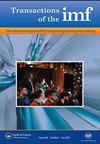Characterization of Copper Oxide Layers by Electrochemical Methods
IF 1.5
4区 材料科学
Q4 ELECTROCHEMISTRY
Transactions of The Institute of Metal Finishing
Pub Date : 1997-01-01
DOI:10.1080/00202967.1997.11871145
引用次数: 2
Abstract
SummaryThe applicability of electrochemical methods for the characterization of oxide layers on copper was examined. The oxide layers were formed at high temperature in air atmosphere and electrochemically in carbonate and bicarbonate solutions. The test methods were cathodic polarisation measurements, cyclic voltammograms and galvanostatic reduction. The composition and the thickness of oxide layers were determined from the galvanostatic curves. The reduction potential range indicates the composition of oxide layer and the reduction time indicates the thickness of the layer in the galvanostatic E-t curves. The 0,1 M Na2CO3 electrolyte gave the sharpest reduction peaks in cyclic voltammograms. The cyclic voltammograms abo proved that the oxide layers formed in air at higher temperature differ from the electrochemically formed oxide layers. Both the parabolic and the logarithmic oxidation rate laws were found to be applicable in air oxidation.用电化学方法表征氧化铜层
研究了电化学方法在铜表面氧化层表征中的适用性。氧化层是在高温下在空气中形成的,在碳酸盐和碳酸氢盐溶液中电化学形成的。测试方法是阴极极化测量,循环伏安图和恒流还原。通过恒流曲线确定了氧化层的组成和厚度。在恒流E-t曲线上,还原电位范围表示氧化层的组成,还原时间表示氧化层的厚度。0.1 M Na2CO3电解质在循环伏安图上呈现出最明显的还原峰。循环伏安图证明了在较高温度下在空气中形成的氧化层与电化学形成的氧化层不同。发现抛物线和对数氧化速率定律都适用于空气氧化。
本文章由计算机程序翻译,如有差异,请以英文原文为准。
求助全文
约1分钟内获得全文
求助全文
来源期刊

Transactions of The Institute of Metal Finishing
工程技术-材料科学:膜
CiteScore
3.40
自引率
10.50%
发文量
62
审稿时长
3 months
期刊介绍:
Transactions of the Institute of Metal Finishing provides international peer-reviewed coverage of all aspects of surface finishing and surface engineering, from fundamental research to in-service applications. The coverage is principally concerned with the application of surface engineering and coating technologies to enhance the properties of engineering components and assemblies. These techniques include electroplating and electroless plating and their pre- and post-treatments, thus embracing all cleaning pickling and chemical conversion processes, and also complementary processes such as anodising. Increasingly, other processes are becoming important particularly regarding surface profile, texture, opacity, contact integrity, etc.
 求助内容:
求助内容: 应助结果提醒方式:
应助结果提醒方式:


